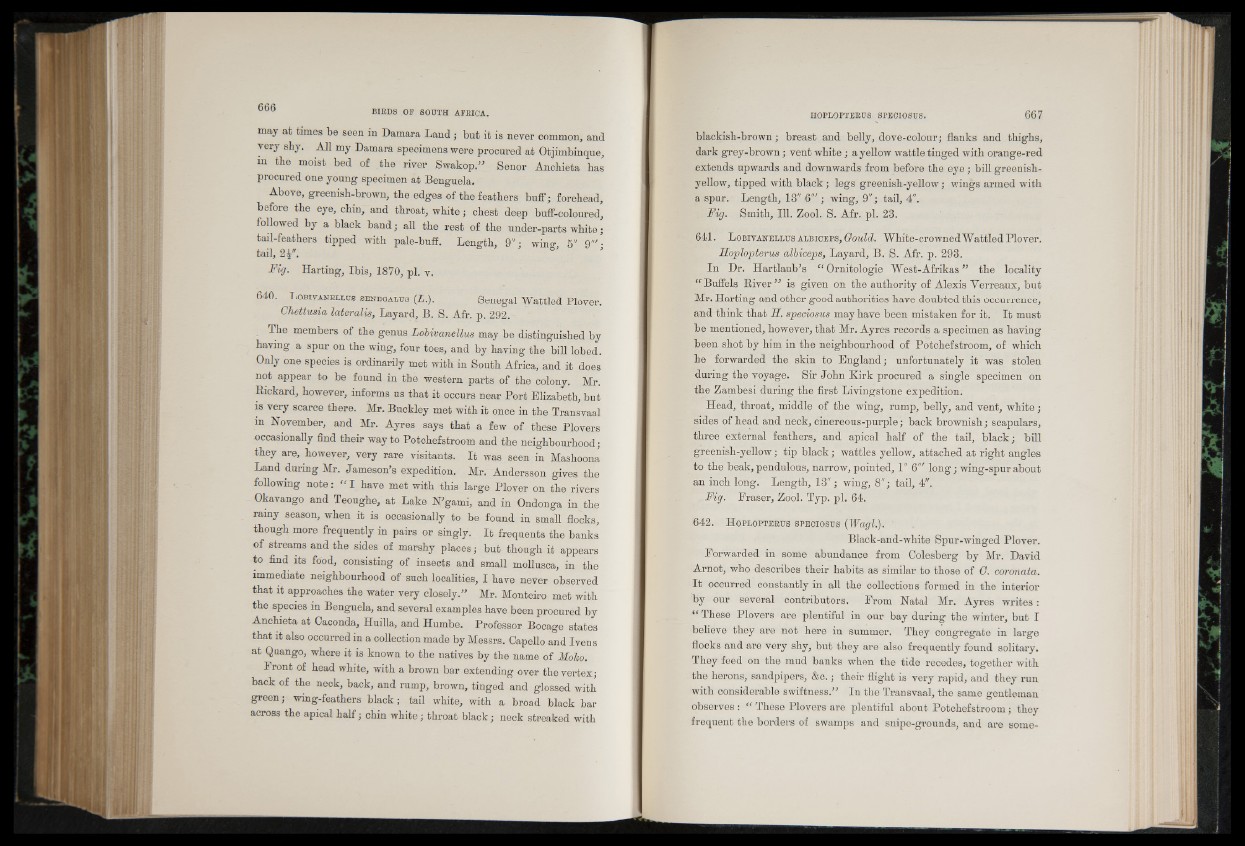
may at times be seen in Damara Land; but it is never common, and
very shy. All my Damara specimens were procured at Otjimbinque,
m the moist bed of the river Swakop.” Senor Anchieta has
procured one young specimen at Benguela,
Above, greenish-brown, the edges of the feathers buff; forehead,
before the eye, chin, and throat, white; chest deep buff-coloured,
followed by a black band; all the rest of the under-parts white;
tail-feathers tipped with pale-buff. Length, 9"; wine1 5" 9"' ■
tail, 2 S
Fig. Harting, Ibis, 1870, pi. v.
640. L obivanellus senegalus (L.). Senegal Wattled Plover.
Ghettusia lateralis, Layard, B. S. Afr. p. 292.
The members of the genus Lobivanellus may be distinguished by
having a spur on the wing, four toes, and by having the bill lobed.
Only one species is ordinarily met with in South Africa, and it does
not appear to be found in the western parts of the colony. Mr.
Rickard, however, informs us that it occurs near Port Elizabeth, but
is very scarce there. Mr. Buckley met with it once in the Transvaal
m November, and Mr. Ayres says that a few of these Plovers
occasionally find their way to Potchefstroom and the neighbourhood;
they are, howeyer, very rare visitants. It was seen in Mashoona
Land during Mr. Jameson’s expedition. Mr. Andersson gives the
following note: “ I have met with this large Plover on the rivers
Okavango and Teoughe, at Lake N’garni, and in Ondonga in the
rainy season, when it is occasionally to be found in small flocks,
though more frequently in pairs or singly. It frequents the banks
of streams and the sides of marshy places; but though it appears
to find its food, consisting of insects and small mollusca, in the
immediate neighbourhood of such localities, I have never observed
that it approaches the water very closely.” Mr. Monteiro met with
the species in Benguela, and several examples have been procured by
Anchieta at Caconda, Huilla, and Humbe. Professor Bocage states
that it also occurred in a collection made by Messrs. Capello and Ivens
at Quango, where it is known to the natives by the name of Molco.
Front of head white, with a brown bar extending over the vertex;
back of the neck, back, and rump, brown, tinged and glossed with
green; wing-feathers black; tail white, with a broad black bar
across the apical half; chin white'; throat black; neck streaked with
blackish-brown; breast and belly, dove-colour; flanks and thighs,
dark grey-brown; vent white; a yellow wattle tinged with orange-red
extends upwards and downwards from before the eye; bill greenish-
yellow, tipped with black; legs greenish-yellow; wings armed with
a spur. Length, 13" Q" '; wing, 9"; tail, 4".
Fig. Smith, 111. Zool. S. Afr. pi. 23.
641. L obivanellus a lb ic e p s , Gould. White-crowned Wattled Plover.
Hoplopterus albiceps, Layard, B. S. Afr. p. 293.
In Dr. Hartlaub’s “ Ornitologie West-Afrikas ” the locality
“ Buffels River” is given on the authority of Alexis Verreaux, but
Mr. Harting and other good authorities have doubted this occurrence,
and think that H. speciosus may have been mistaken for it. It must
be mentioned, however, that Mr. Ayres records a specimen as having
been shot by him in the neighbourhood of Potchefstroom, of which
he forwarded the skin to England; unfortunately it was stolen
during the voyage. Sir John Kirk procured a single specimen on
the Zambesi during the first Livingstone expedition.
Head, throat, middle of the wing, rump, belly, and vent, white;
sides of head and neck, cinereous-purple; back brownish; scapulars,
three external feathers, and apical half of the tail, black; bill
greenish-yellow; tip black; wattles yellow, attached at right angles
to the beak,pendulous, narrow, pointed, 1" 6"' long; wing-spurabout
an inch long. Length, 13"; wing, 8"; tail, 4".
Fig. Eraser, Zool. Typ. pi. 64.
642. H oplopterus speciosus (Wagl.).
Black-and-white Spur-winged Plover.
Forwarded in some abundance from Colesberg by Mr. David
Arnot, who describes their habits as similar to those of G. coronata.
It occurred constantly in all the collections formed in the interior
by our several contributors. Prom Natal Mr. Ayres writes:
“ These Plovers are plentiful in our bay during the winter, but I
believe they are not here in summer. They congregate in large
flocks and are very shy, but they are also frequently found solitary.
They feed on the mud banks when the tide recedes, together with
the herons, sandpipers, &c.; their flight is very rapid, and they run
with considerable swiftness.” In the Transvaal, the same gentleman
observes : “ These Plovers are plentiful about Potchefstroom; they
frequent the borders of swamps and snipe-grounds, and are some